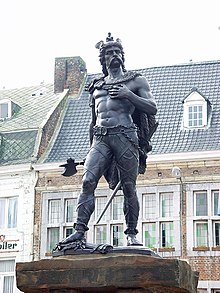Ambiorix
This article needs additional citations for verification. (March 2022) |
Ambiorix | |
|---|---|
 Statue of Ambiorix in Tongeren, Belgium. | |
| King and chieftain of the Belgae | |
| Prince of the Eburones | |
| Personal details | |
| Born | Unknown |
| Died | Unknown year in the era BC Gaul |
Ambiorix (Gaulish "king of the surroundings", or "king-protector") (fl. 54–53 BC) was, together with Cativolcus, prince of the Eburones, leader of a Belgic tribe of north-eastern Gaul (Gallia Belgica), where modern Belgium is located. In the nineteenth century Ambiorix became a Belgian national hero because of his resistance against Julius Caesar, as written in Caesar's Commentarii de Bello Gallico.[1]
Name
It is generally accepted that Ambiorix is a Gaulish personal name formed with the prefix ambio- attached to rix ('king'), but the meaning of the first element is debated.[2] Some scholars translate Ambiorix as the 'king of the surroundings' or 'king of the enclosure', by interpreting ambio- as a thematized form of ambi- ('around, on both sides') meaning 'surroundings' or else 'enclosure' (cf. Old Irish imbe 'enclosure').[3][4][5] Alternatively, Fredrik Otto Lindeman renders Ambiorix as the 'protector-king', by deriving ambio- from the Proto-Indo-European compound *h₂mbhí-péh₃ ('protector'; cf. Old Indic adhi-pá- 'protector, ruler, master, king').[6][7]
Biography
Early history
In 57 BC Julius Caesar conquered parts of
Although
Resisting the Romans

Because a drought had disrupted his grain supply, Caesar was forced to winter his legions among the rebellious Belgic tribes. Roman troops led by Sabinus and Cotta were wintering among the Eburones when they were attacked by them, led by Ambiorix and Cativolcus. Ambiorix deceived the Romans, telling them the attack was made without his consent, and further advised them to flee as a large Germanic force was preparing to cross the Rhine. Trusting Ambiorix, Sabinus and Cotta's troops left the next morning. A short distance from their camp, the Roman troops were ambushed by the Eburones and massacred.
Elsewhere, another Roman force under Quintus Tullius Cicero, younger brother of the orator Marcus, were wintering amongst the Nervii. Leading a coalition of rebellious Belgic tribes, Ambiorix surrounded Cicero's camp. After a long while, a Roman messenger was finally able to slip through the Belgic lines and get word of the uprising to Caesar. Mobilizing his legions, Caesar immediately marched to Cicero's aid. As they approached the besieged Roman camp, the Belgae moved to engage Caesar's troops. Vastly outnumbered, Caesar ordered his troops to appear confused and frightened, and they successfully lured the Belgae to attack them on ground favourable to the Romans. Caesar's forces launched a fierce counterattack, and soon put the Belgae to flight. Later, Caesar's troops entered Cicero's camp to find most of the men wounded.
Meanwhile, Indutiomarus, a leader of the Treveri, began to harass Labienus's camp daily, eventually provoking Labienus to send out his cavalry with specific orders to kill Indutiomarus. They did so, and routed the remnants of Indutiomarus's army. Caesar personally remained in Gaul for the remainder of winter due to the renewed Gallic threat.
Caesar's revenge
When the
Legacy
Caesar wrote about Ambiorix in his commentary about his battles against the Gauls,
Ambiorix remained a relatively obscure figure until the nineteenth century. The independence of Belgium in 1830 spurred a search for
Today, Ambiorix is one of the most famous characters in
In the French comic
In popular culture
- Ambiorix leads the Gallic civilization in the New Frontier season pass of the 4X video game Civilization VI.[10]
References
- ^ Smith, William (1867). "Ambiorix". In William Smith (ed.). Dictionary of Greek and Roman Biography and Mythology. Vol. 1. Boston: Little, Brown and Company. pp. 138–139. Archived from the original on November 2, 2013.
- ^ Evans 1967, pp. 134–136; Lambert 1995, pp. 116–117; Delamarre 2003, pp. 41–42; Lindeman 2007, p. 53; Toorians 2013, pp. 114–115.
- ^ Evans 1967, pp. 134–136.
- ^ Lambert 1995, pp. 115–116.
- ^ Delamarre 2003, pp. 41–42.
- ^ Lindeman 2007, p. 53.
- ^ Toorians 2013, pp. 114–115.
- ^ Florus, iii. 10. § 8
- ^ "Ambionix official home page". Archived from the original on 2008-09-15.
- ^ "Civilization VI - First Look: Gaul Civilization VI - New Frontier Pass". Official Civilization Website. September 22, 2020. Archived from the original on 2021-11-22. Retrieved September 22, 2020.
Bibliography
- ISBN 9782877723695.
- OCLC 468437906.
- .
- .
- Toorians, Lauran (2013). "Aduatuca, 'place of the prophet'. The names of the Eburones as representatives of a Celtic language, with an excursus on Tungri". In Creemers, Guido (ed.). Archaeological Contributions to Materials and Immateriality. Gallo-Roman Museum of Tongeren. ISBN 978-90-74605-61-8. Archived(PDF) from the original on 2022-10-09.
Primary sources
- Caesar, De Bello Gallico v. 26–51, vi. 29–43, viii. 24; Dio Cassius xl. 7-11; Florus iii. 10.
